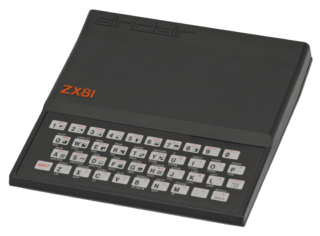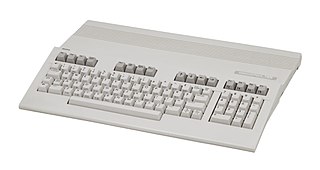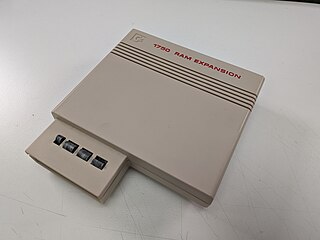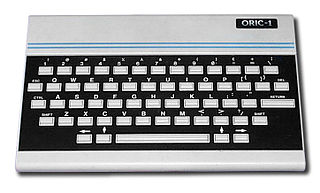
The Commodore 64, also known as the C64, is an 8-bit home computer introduced in January 1982 by Commodore International. It has been listed in the Guinness World Records as the highest-selling single computer model of all time, with independent estimates placing the number sold between 12.5 and 17 million units. Volume production started in early 1982, marketing in August for US$595. Preceded by the VIC-20 and Commodore PET, the C64 took its name from its 64 kilobytes(65,536 bytes) of RAM. With support for multicolor sprites and a custom chip for waveform generation, the C64 could create superior visuals and audio compared to systems without such custom hardware.

ColecoVision is a second-generation home video-game console developed by Coleco and launched in North America in August 1982. It was released a year later in Europe by CBS Electronics as the CBS ColecoVision.

The Sinclair ZX80 is a home computer launched on 29 January 1980 by Science of Cambridge Ltd.. It is notable for being one of the first computers available in the United Kingdom for less than a hundred pounds. It was available in kit form for £79.95, where purchasers had to assemble and solder it together, and as a ready-built version at £99.95.

The ZX Spectrum is an 8-bit home computer developed and marketed by Sinclair Research. It has been considered as one of the most influential computers ever made, and is also one of the best selling computers ever, with over five million units sold. It was first released in the United Kingdom on 23 April 1982, and around the world in the following years, most notably in Europe, the United States, and Eastern Bloc countries.

The ZX81 is a home computer that was produced by Sinclair Research and manufactured in Dundee, Scotland, by Timex Corporation. It was launched in the United Kingdom in March 1981 as the successor to Sinclair's ZX80 and designed to be a low-cost introduction to home computing for the general public. It was hugely successful; more than 1.5 million units were sold. In the United States it was initially sold as the ZX-81 under licence by Timex. Timex later produced its own versions of the ZX81: the Timex Sinclair 1000 and Timex Sinclair 1500. Unauthorized ZX81 clones were produced in several countries.

The Atari 8-bit computers, formally launched as the Atari Home Computer System, are a series of 8-bit home computers introduced by Atari, Inc. in 1979 with the Atari 400 and Atari 800. It is the first home computer architecture with coprocessors, enabling more advanced graphics and sound than most of its contemporaries. Video games are key to its software library, and the 1980 first-person space combat simulator Star Raiders is considered the platform's killer app.

The Commodore 128, also known as the C128, C-128, or C= 128, is the last 8-bit home computer that was commercially released by Commodore Business Machines (CBM). Introduced in January 1985 at the CES in Las Vegas, it appeared three years after its predecessor, the Commodore 64, the bestselling computer of the 1980s. Approximately 2.5 million C128s were sold during its four year production run.

The VIC-20 is an 8-bit home computer that was sold by Commodore Business Machines. The VIC-20 was announced in 1980, roughly three years after Commodore's first personal computer, the PET. The VIC-20 was the first computer of any description to sell one million units. It was described as "one of the first anti-spectatorial, non-esoteric computers by design...no longer relegated to hobbyist/enthusiasts or those with money, the computer Commodore developed was the computer of the future."

The TI-99/4 and TI-99/4A are home computers released by Texas Instruments in 1979 and 1981, respectively. The TI-99 series competed against home computers such as the Apple II, TRS-80, Atari 400/800, and VIC-20.

The Coleco Adam is a home computer and expansion device for the ColecoVision by American toy and video game manufacturer Coleco. The Adam was an attempt to follow on the success of the company's ColecoVision video game console. It was available as Expansion Module #3 for the ColecoVision, converting it into a home computer, and as a standalone unit. As such, it had the benefit of being entirely compatible with all ColecoVision games and peripherals. The computer came with 64 KB of memory, a tape drive for a proprietary medium called Digital Data Packs, a daisy wheel printer, and productivity applications, along with two DDPs for SmartBASIC and Buck Rogers: Planet of Zoom Super Game. It was released in October 1983 with the initial price of $700.
Sinclair BASIC is a dialect of the programming language BASIC used in the 8-bit home computers from Sinclair Research, Timex Sinclair and Amstrad. The Sinclair BASIC interpreter was written by Nine Tiles Networks Ltd.

The Timex Sinclair 1000 was the first computer produced by Timex Sinclair, a joint venture between Timex Corporation and Sinclair Research. It was launched in July 1982, with a US sales price of US$99.95, making it the cheapest home computer at the time; it was advertised as "the first computer under $100". The computer was aimed at regular home users. As purchased, the T/S 1000 was fully assembled and ready to be plugged into home televisions, which served as a video monitor. The T/S 1000 was a slightly modified version of the Sinclair ZX81 with an NTSC RF modulator, for use with North American TVs, instead of PAL for European TVs. The T/S 1000 doubled the onboard RAM from 1 KB to 2 KB; further expandable by 16 KB through the cartridge port. The T/S 1000's casing had slightly more internal shielding but remained the same as Sinclair's, including the membrane keyboard. Just like the ZX81, the T/S 1000 had black-and-white graphics and no sound.

The Mindset is an Intel 80186-based MS-DOS personal computer. It was developed by the Mindset Corporation and released in spring 1984. Unlike other IBM PC compatibles of the time, it has custom graphics hardware supporting a 320×200 resolution with 16 simultaneous colors and hardware-accelerated drawing capabilities, including a blitter, allowing it to update the screen 50 times as fast as an IBM standard color graphics adapter. The basic unit was priced at US$1,798. It is conceptually similar to the more successful Amiga released over a year later. Key engineers of both the Amiga and Mindset were ex-Atari, Inc. employees.

The Commodore RAM Expansion Unit (REU) is a range of external RAM add-ons.

The Atari Portfolio is an IBM PC-compatible palmtop PC, released by Atari Corporation in June 1989. This makes it the world's first palmtop computer.

The Commodore 64 home computer used various external peripherals. Due to the backwards compatibility of the Commodore 128, most peripherals would also work on that system. There is also some compatibility with the VIC-20 and Commodore PET.

A ROM cartridge, usually referred to in context simply as a cartridge, cart, or card, is a replaceable part designed to be connected to a consumer electronics device such as a home computer, video game console or, to a lesser extent, electronic musical instruments.
Nintendo 64 accessories are first-party Nintendo hardware—and third-party hardware, licensed and unlicensed. Nintendo's first-party accessories are mainly transformative system expansions: the 64DD Internet multimedia platform, with a floppy drive, video capture and editor, game building setup, web browser, and online service; the controller plus its own expansions for storage and rumble feedback; and the RAM-boosting Expansion Pak for big improvements in graphics and gameplay. Third-party accessories include the essential game developer tools built by SGI and SN Systems on Nintendo's behalf, an unlicensed SharkWire online service, and unlicensed cheaper counterparts to first-party items. In the fifth generation of video game consoles, the Nintendo 64 had a market lifespan from 1996 to 2002.
Richard Francis Altwasser is a British engineer and inventor, responsible for the hardware design of the ZX Spectrum.

Oric was a brand of home computers sold in the 1980s by Tangerine Computer Systems. Tangerine was based in the United Kingdom and sold their computers primarily in Europe. All computers in the Oric line were based on the MOS Technology 6502A microprocessor.
















